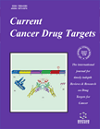- Home
- A-Z Publications
- Current Cancer Drug Targets
- Previous Issues
- Volume 8, Issue 4, 2008
Current Cancer Drug Targets - Volume 8, Issue 4, 2008
Volume 8, Issue 4, 2008
-
-
S100A8 and S100A9 Overexpression Is Associated with Poor Pathological Parameters in Invasive Ductal Carcinoma of the Breast
More LessAuthors: Kazumori Arai, Sachiko Takano, Takumi Teratani, Yasuhiro Ito, Toshihiro Yamada and Ryushi NozawaS100 protein A8 and A9 naturally form a stable heterocomplex. Recently, we have proved that S100A9 overexpression in various adenocarcinomas is associated with poor tumor differentiation. In this study, we examined the relationship between the expression of each protein and the pathological parameters that reflect the aggressiveness of carcinoma, in invasive ductal carcinoma (IDC) of the breast. Serial paraffin-e Read More
-
-
-
Cancer Neovascularization and Proinflammatory Microenvironments
More LessAuthors: Mitsuko Furuya and Yoshikazu YonemitsuTumor neovascularization plays critical roles for the development, progression and metastasis of cancers via utilizing blood flow to supply nutrients and oxygen. Recent cumulative information on biology of tumor neovascularization from both laboratory and clinical studies has opened us to develop new therapeutic approaches to treat malignancies by controlling angiogenic activities; i.e., a humanized monoclonal antibody b Read More
-
-
-
Targeting Cancer and Neuropathy with Histone Deacetylase Inhibitors:Two Birds with One Stone?
More LessAuthors: V. Rodriguez-Menendez, L. Tremolizzo and G. CavalettiHistone deacetylase inhibitors (HDACi) belong to a novel class of drugs able to act on the epigenome, indirectly remodeling the spatial conformation of the chromatin: by increasing histone acetylation these drugs ultimately promote the detachment of the DNA from the nucleosome octamer, therefore allowing the access of transcription factors to the double helix. Such a mechanism of action is of particular interest i Read More
-
-
-
The Inhibitor of Growth (ING) Gene Family: Potential Role in Cancer Therapy
More LessAuthors: Mehmet Gunduz, Esra Gunduz, Rosario S. Rivera and Hitoshi NagatsukaThe discovery of ING1 gene paved the way to the identification of other ING members (ING2-5) and their isoforms associated with cell cycle, apoptosis and senescence. The ING family has been an emerging putative tumor suppressor gene (TSG) in which the major mechanism is through interaction with the determinants of chromatin function and gene-specific transcription factors. The regulatory mechanism highly involv Read More
-
-
-
Skeletal Muscle in Cancer Cachexia: The Ideal Target of Drug Therapy
More LessAuthors: Maurizio Bossola, Fabio Pacelli, Antonio Tortorelli, Fausto Rosa and Giovan B. DogliettoCancer cachexia is a debilitating and life-threatening syndrome that accounts for at least 20% of deaths in neoplastic patients. Cancer cachexia significantly impairs quality of life and response to anti-neoplastic therapies, increasing morbidity and mortality of cancer patients. The loss of lean body mass is the main characteristic of cancer cachexia and the principal cause of function impairment, fatigue and respiratory complic Read More
-
-
-
Regulators of Chemokine Receptor Activity as Promising Anticancer Therapeutics
More LessChemokines are a family of small proteins inducing directed cell migration via specific chemokine receptors, which play important roles in a variety of biological and pathological processes. Their respective ligands act as proinflammatory mediators that primarily control leukocyte migration into selected tissues and upregulation of adhesion receptors, and also have a role in pathological conditions that require neovascularization. Read More
-
-
-
Erratum
More LessDue to an oversight on the part of the authors, Nikia A. Laurie, Chie Schin-Shih, and Michael A. Dyer, incorrect name of one of the co-author was published in the review entitled “Targeting MDM2 and MDMX in Retinoblastoma”, Current Cancer Drug Targets, November 2007, Vol. 7(7), pp. 689-695. The correct name of the author is Chie-Schin Shih instead of Chie Schin-Shih.
-
Volumes & issues
-
Volume 25 (2025)
-
Volume 24 (2024)
-
Volume 23 (2023)
-
Volume 22 (2022)
-
Volume 21 (2021)
-
Volume 20 (2020)
-
Volume 19 (2019)
-
Volume 18 (2018)
-
Volume 17 (2017)
-
Volume 16 (2016)
-
Volume 15 (2015)
-
Volume 14 (2014)
-
Volume 13 (2013)
-
Volume 12 (2012)
-
Volume 11 (2011)
-
Volume 10 (2010)
-
Volume 9 (2009)
-
Volume 8 (2008)
-
Volume 7 (2007)
-
Volume 6 (2006)
-
Volume 5 (2005)
-
Volume 4 (2004)
-
Volume 3 (2003)
-
Volume 2 (2002)
-
Volume 1 (2001)
Most Read This Month
Article
content/journals/ccdt
Journal
10
5
false
en


